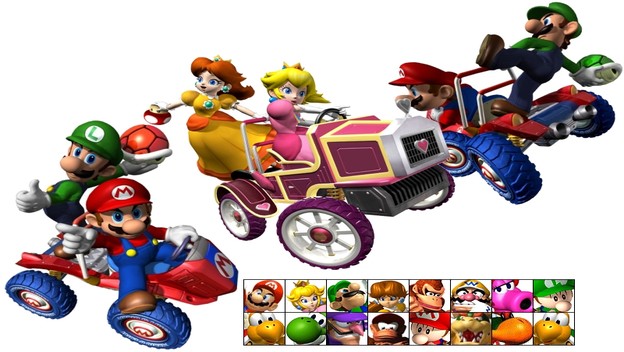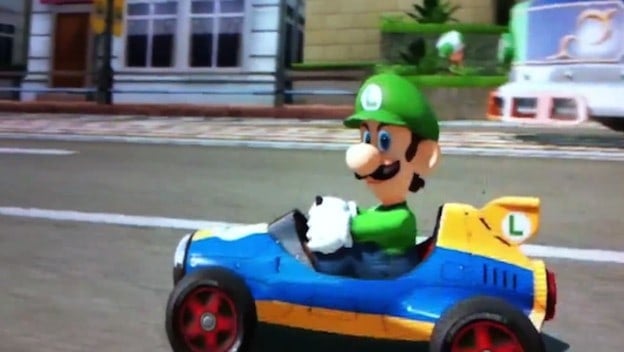About three weeks after Mario Kart 8 came out, a close friend of mine traded in his copy of the game. Since I’m a certain kind of friend and I thought I had a pretty good understanding of the franchise’s mechanics, (mostly because I had written an impenetrable defense of the infamous Blue Shell ) I decided I was in a good position to chastise him. I called him silly, I mused on the evils of supporting GameStop’s dubious secondhand market, and questioned his integrity as a gamer, all in good fun. But once I was done with the playful onslaught, curiosity got the better of me and I asked him for his genuine reasoning. His answer? Mario Kart 8 somehow managed to feel too polished to him, and it didn’t take long for the game to become repetitive and dull.
Over the next couple of weeks, his reasoning nagged at me. The more I played the game, the more sense it made. I was reminded of the time he told me It’s Always Sunny in Philadelphia was trying too hard and temporary hindered my ability to enjoy the show. But, unlike that example, he may have happened across a salient point that wasn’t merely grounded in cynicism. All my races were virtually the same as one another. It occurred to me that Mario Kart 8 was really just a tuned up version of Mario Kart 7 and far less daring a title than some of the other entries in the series. The realization that this game was a “safe” move from the normally innovative and experimental company, Nintendo, felt like a curse that slowly sapped my ability to enjoy the game, despite the high praise I had once given it. I began to wish I hadn’t purchased the game digitally, because I was actually considering following in my friend’s footsteps.
It’s true that Mario Kart 8 has some clever mechanics in play. The way items are distributed among the pack helps keep the racers in direct competition with one another, and nobody feels like their chances of victory are absolutely hopeless at any given time. With around 20 items available, one would think that there would be plenty of varied chaos to keep things interesting. Sadly, that is not the case in Mario Kart 8 . Something just feels amiss, and I’m forced to draw comparisons to other, less polished games that I actually liked a good deal more.
In Mario Kart 8 , the top 5 players really don’t acquire that many different items. If you’re one of the front runners in a race and you pass someone, there’s a good chance that that person has a red shell or three waiting for you. And the person that is about to pass that racer also probably has a shell or three. Ahead of you, you’re probably looking at mushrooms and bananas. Unless you’re doing poorly, you’re unlikely to see some of the game’s cooler items, and even those aren’t that magnificent.
The reason for this distribution is that Nintendo desperately wants to make a game that appeals to players of the “for glory” camp and the “for fun” camp simultaneously. Logically, they seem to have done that this time around, since skilled players do manage to come in ahead of others more often than not. Knowledge of mechanics, shortcuts, and whatnot pay off against less experienced gamers. The hardcore get to win more often, and the “casuals,” or whatever we’re calling them now, still get to feel like they’ve got a chance. Nintendo has succeeded to that end, but I can’t help but think that they could have taken different routes or negotiated a different balance that would’ve made for a better game. And worst of all, the mechanics that I think I’m longing for have already been used in the franchise before; namely in Mario Kart Double Dash and the lesser known arcade title, Mario Kart GP DX . Those two titles are arguably the two most ambitious entries in the series in terms of items, and they really seem to stand out because of it.
Mario Kart Double Dash had a unique mechanic where players could choose two characters to operate a Kart. One character would drive, while the other, in charge of items, would cling to the back and dish out the hurt. While the cooperative play added its own dynamic to the game, a design element that made certain items exclusive to certain characters added a level of strategy to the game before you even started the race.
Sure, there are a slew of different Kart options now available in Mario Kart 8 , but the characters themselves never feel all that different. By allowing players to choose two characters with their own unique items in Double Dash , Nintendo accomplished three important things: they made characters feel unique, they offered more options in playstyle, and they ensured that every race would have player selected variables to mix things up. If you don’t think that makes a difference, I challenge you to play on Baby Park against a player using the bob-omb wielding bros, Wario and Waluigi; the difference becomes clear. The system also made triple red shells and triple green shells unique to specific characters, which was nice since those are two of the least exciting and most frustrating items in the franchise.

Mario Kart GP DX took an even more dramatic approach to item usage. Since the game costs money to play, every single time you use it, developer Namco was likely seeking a way to make each play session unique. The fact that the game contains 100 different items certainly provides an incentive for players who want to see everything the game has to offer. The way the game manages to incorporate all 100 items is a bit unique, too. Since the arcade cabinet is operated by a steering wheel, players have no way of inputting up or down in order to direct their items frontwards or backwards. The game compensates for this by selecting, via roulette, the items the player will have available to them at the start of the match; a forward-shooting item, a rear-shooting item, and a droppable item. Hitting item boxes will reward the player with an item from their previously determined toolkit.
Now, a system exactly like that would likely be a mismatch in a game like Mario Kart 8 . But the idea of randomly determined toolkits does hold some merit, and could facilitate a larger variety of items while curbing the repetitive nature of races. If Mario Kart 8 would have had alternate items to fill in the slots of the chain chomp, banana, or red shell, but distributed them in the same charitable way that Mario Kart 8 is known for, then it may have held my attention longer. And if it had the fusion kart item from Mario Kart GP DX , then it may have managed to become my favorite Mario Kart to date.
The Fusion Kart is a staple of the arcade game, and its presence helps enforce what a majority of Double Dash players already suspected; co-operative gameplay feels fierce and more involved. When playing in the cooperative mode of Mario Kart GP DX , players can acquire an item that fuses their Kart with their partner in the position of whichever player is leading. While one player continues to drive, the other mans a turret that fires an infinite supply of green shells for a limited amount of time. Since this item relies on the positioning of a teammate, it feels somehow less cheap than an item like Bullet Bill, and encourages a different approach to racing than is typically viable in the franchise. In fact, cooperative gameplay opens up a plethora of different strategies and introduces the concept of formations to the game.
It’s too late now to do anything about it, and I’m not suggesting Mario Kart 8 is by any means a bad game. In reality, Nintendo probably landed on the most marketable approach to Mario Kart 8 that they could have considering the flack they’ve received by “core” gamers. But if they wish to continue playing it safe with future titles, it is my sincere hope that they take a page from the book of Super Smash Bros. and give gamers a bunch of options for custom races to complement their well-groomed, finely tuned, default settings. Otherwise, it will seem that the Mario Kart franchise has finally stagnated.
